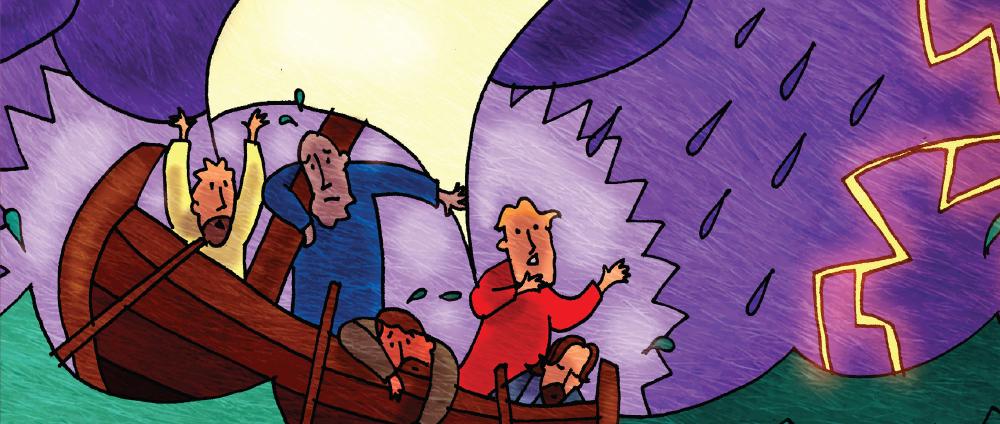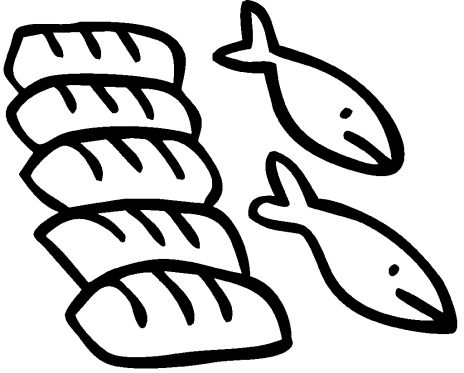
Jesus Feeds a Great Crowd
- Imagine how Jesus fed so many people with just five loaves and two fish.
- Thank Jesus for the food we eat each day.
- Know that Jesus cares when people are hungry.
- Help feed those who are hungry.
Leader Reflection
It's striking that this particular story of Jesus feeding the crowds is the one miracle that occurs in all four gospels. What's so special about this miracle that it was picked up by each of the gospel writers? We don't know the reasons for their selections, of course, but one might have been that all the gospel writers were intent on depicting Jesus as the fulfillment of the covenant promise, the faithful Israelite, and the new Moses. Just as God had fed the Israelites in the wilderness with manna, so the Son of Man would feed God's people with the "bread of life" (see vv. 32-35).
A huge crowd gathers to hear and see Jesus, the great teacher and miracle worker. It's always a bit jarring to recognize just how popular Jesus was with the people. No matter where he went, he was dogged by crowds. Jesus, looking out at the throng, asks the disciples, "Where shall we buy bread for these people to eat?" It was a ridiculous question, given the size of the crowd and the meager purse of the disciples. John explains that Jesus said this to test them. He wants us to know that when we are tested by circumstances that seem beyond our power to handle, we get a glimpse of what God can do.
Philip, the practical one, responds with exasperation, "It would take more than a half year's wages to buy enough for each one to have a bite!" Another helpful disciple pops up with the information that a young boy's lunch has been offered, but he also notes the impossibility of such meager food meeting the needs of a multitude.
I picture Jesus responding with a patient smile. "Have the people sit down," he says. Interestingly, John notes that there was lots of grass (a reference to the "green pastures" of Psalm 23?). Jesus then takes the boy's lunch and begins passing bread and fish to the crowd. Amazingly, the food just keeps coming, till everyone present has their fill; in the end there are twelve basketsful of leftovers. Notice Jesus' concern: "Let nothing be wasted"—a firm reminder for us in our day of more-than-ample plates of food and overflowing dumpsters.
The people, of course, were amazed. They considered Jesus a prophet based on the miracle and even wanted to declare him king. Imagine the hoopla: "A chicken in every pot and a free picnic on every hillside!" And that's when Jesus hightailed it out of there.
John, as usual, calls this miracle a "sign." True to form, the disciples misunderstand its meaning, and Jesus goes on through the rest of the chapter to patiently explain. "I am the bread of life," he says. And toward the end of the chapter he ties up the theme with an allusion to what would become holy communion: "Whoever eats my flesh and drinks my blood has eternal life" (vv. 53-56). In other words, the sign points beyond the miracle of eating to the miracle of the one who alone can satisfy our deepest needs and feed our deepest hungers.
While that's the larger point John makes in this chapter, there's a smaller but still significant application for the children in the group. A young boy offers his lunch to Jesus, and it turns out to be enough to feed a crowd. No matter who we are or how meager our offering may seem to others, Jesus can make something of it.
Steps
Step 1 Breathe
Use this time to focus your attention on God.
Do this with me: calm your head, heart, and hands as you slowly breathe in . . . and out. (Demonstrate a few deep "in and out breaths" with eyes closed.)

Get Unlimited Access!
Sign up for DWELL Digital to unlock all online leader resources, printable pages and session plans.
Call 800-333-8300 or Request Access
Already a subscriber? Log In
Learn About DWELL
DWELL helps kids find their place in God's Big Story. Learn more about this popular and trusted children’s ministry curriculum.
